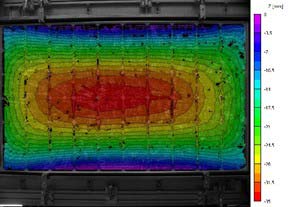Measurement of Photovoltaic Cell Crack Characteristics in Modules Using Digital Image Correlation
DuraMAT is using digital image correlation (DIC) to measure photovoltaic (PV) cell crack apertures as a function of mechanical and thermal stress. DIC is a technique that compares sequential images to identify fine-scale displacements and distortions in a sample.
While much effort has been made to identify the presence and length of PV cell cracks in laminated modules using electroluminescence (EL) and ultraviolet fluorescence (UVF) imaging techniques, little is known about the distribution of crack apertures or gaps and how they change with changing temperature and mechanical stress. The major reason for this lack of understanding is that it is very difficult to accurately measure crack apertures in full-sized modules with existing optical methods (e.g., microscopy, optical profilometry, etc.).
Core Objective
Multi-Scale, Multi-Physics Modeling
Location
Sandia National Laboratories
Applications
DIC can be used to measure module deflections and PV cell crack displacements due to stress applied to a PV module.
Availability
Available to researchers at Sandia National Laboratory.
References
Haase, F., et al. (2018). "Fracture Probability, Crack Patterns, and Crack Widths of Multicrystalline Silicon Solar Cells in PV Modules During Mechanical Loading." Journal of Photovoltaics 8(6): 1510-1524.
Webinar: "Detailed Investigations into PV Cell Cracks – Why Some Cracks Can Lead to Power Loss" presented by Josh Stein, Sandia, and Cara Libby, EPRI
Contact
To learn more about the project, contact Joshua S. Stein or Jennifer L. Braid.

Full module displacement result from DIC measured at Sandia (-3500 Pa)